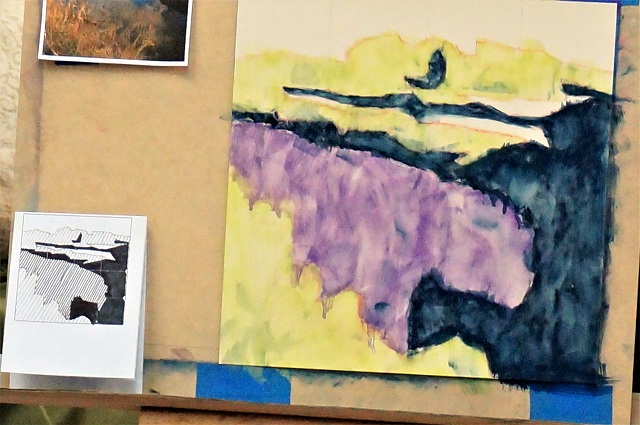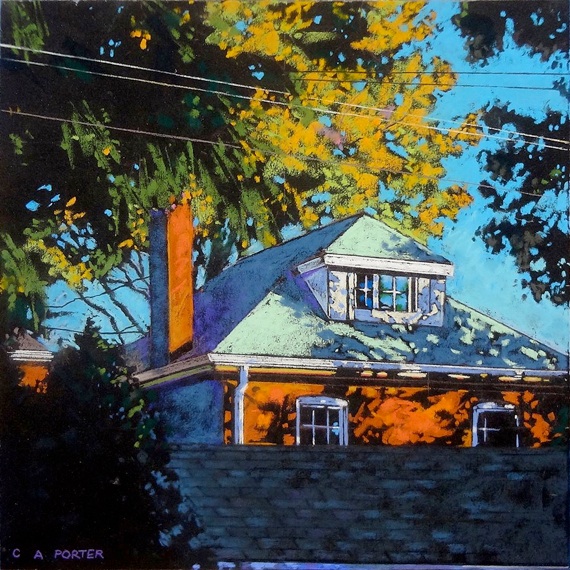Friday Night Club March 1/19 – Clarence Porter – PASTELS: WHY NOT?
PASTELS – Why not? This question was answered by our guest, Clarence Porter, as he set out to enlighten us on the fundamentals and ease of use of pastels.
Clarence is a professional freelance illustrator and painter. He teaches various courses in the Visual and Creative Arts diploma program at Sheridan. He also has his Pastel Artist of Canada Master Pastelist designation and is a signature member of the Pastel Society of America. His work has been shown in many group and solo shows.
Clarence is an engaging and experienced instructor and organized his presentation in order to fulfill a number of learning outcomes.
- Soft pastels and chalk are not the same. Chalk is made of limestone or gypsum and compressed into a stick. Soft pastels are pure pigment the same as oil and acrylic paints and is held together with binder. The difference between soft and hard pastels is the amount of binder. Softer pastels have less binder and therefore will leave more pigment on the paper. Both have their uses and the decision to use either is often a personal preference. Hard pastels will make sharper lines and are often used in the original sketch while soft pastels leave a smooth, creamy stroke and are easily layered and blended. A newer type of pastel called Pan Pastels is another method of pastel painting and is often combined with other types of pastels. This product comes in small plastic pans and is applied with sponge type tools. It allows for a smooth flow of pigment and has excellent blending qualities.
- As is true with watercolour painting, the type of paper and substrate makes a HUGE difference in the outcome of your painting. There are many types of papers available specifically for pastel but the type used, again, becomes the preference of the artist and the desired outcome. Tooth is important if you wish to layer your colours. It’s like glazing in wet mediums. The more tooth or texture a paper has, the more layers you can apply, as the pastel is less likely to fall off. However, if you want to do a lot of blending as in portraits, you might prefer a smoother paper.
Papers with tooth are also called sanded papers. Much like regular workshop sandpapers, they are manufactured for pastel painting and come in a variety of grades.
Clarence prefers Uart, but there are a variety of brands that produce great results. Clairefontaine Pastelmat, Sennelier Pastel Card, Mi-teintes Touch, Colourfix etc. You can also create your own substrate on any surface by applying a pastel ground. Golden Pastel Ground is an acrylic preparation for pastels on canvas and other supports. It creates toothy surface similar to papers used with pastel and chalk. For an even rougher texture Fine or Coarse Pumice Gel can be added. Acrylic Ground for Pastel can also be tinted with acrylic colors.
- Clarence suggested that when using sanded papers, a light touch is required, otherwise the tooth fills quickly and reduces the number of future application of layers. While softer pastels will allow for many layers, using a harder pastel will allow for sharper lines, keeping in mind that a harder application will also fill in the tooth. Hard pastels will not adhere well to softer under layers so it is wise to work hard to soft.
- Clarence suggested that when starting a painting he works from dark to light, as pastels are easily layered, it allows for an outline of the coming subject. He also does thumbnail sketches, as with other mediums. However, he also does under paintings using alcohol instead of water. This will only work on some types of sanded papers, as not all papers are welcoming to wet applications. The alcohol makes for a permanent under sketch and gives a firm outline. This does not mean you have to follow it exactly and allows for variations in the composition.
- Pastels can be combined with other mediums and can be quite versatile in their usage. Charcoal, acrylic and watercolour are the most commonly used mediums that can be included to achieve wonderful results in a painting. Acrylic mediums like modelling paste can also be applied to achieve texture.
Pastel painting is making a comeback. It is a fun and vibrant medium that is quite forgiving. So, did Clarence answer the question? PASTELS – WHY NOT? Although there was maybe a half dozen people in attendance who use or have tried pastels, perhaps there will be some recruits in the future.
Clarence Porter has an engaging personality and endeared himself to our DVAC Friday Night Club. You may view his work at the following link: http://www.porter-arts.com/Galleries.html








